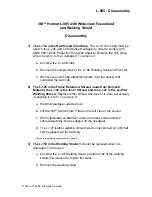
7
Maintenance and Operations
Failure to maintain correct minimum pressure (or pressure proportional to load),
bottoming out, over-extension, or rubbing against another component will void the
warranty.
MAXIMUM AIR PRESSURE
MINIMUM AIR PRESSURE
10 p.s.i.
100 p.s.i.
Maintenance:
1. Check pressure weekly.
2. Always maintain at least 10 p.s.i. air pressure to prevent chafing.
3. If you develop an air leak in the system, use a liquid solution of
1
/
4
dish soap to
4
/
5
water to check all air line
connections and the inflation valve core before removing sleeve.
Operating Tips:
1. Inflate your air springs to 60 p.s.i. before adding the payload. After vehicle is loaded, adjust your air pressure to
level the vehicle and for ride comfort.
2. When you are carrying a payload it will be helpful to increase the tire inflation pressure in proportion to any
overload condition. We recommend a 2 p.s.i. increase above normal (not to exceed tire manufacturer maximum)
for each 100 lbs total overload on the axle.
NOTE:
1. IMPORTANT: For your safety and to prevent possible damage to your vehicle, do not exceed maximum load recommended
by the vehicle manufacturer. Although your air springs are rated at maximum inflation pressure of 100 p.s.i., the air pressure
actually needed is dependant upon your load and Gross Vehicle Weight Rating (GVWR), which may be less than 100 p.s.i.
Check your vehicle owner’s manual and do not exceed maximum loads listed for your vehicle. When inflating your Air Lift air
spring, add pressure in small quantities, checking pressure frequently during inflation. The sleeves require much less air
volume than a tire and therefore inflate much quicker.
2. Should it become necessary to raise the vehicle by the frame, make sure the system is at minimum pressure (10 p.s.i.) to
reduce the tension on suspension/brake components. Check to see that the sleeve rolls back down over the bottom piston
after the vehicle is lowered (Figure 9). If sleeve fails to roll back down over the piston, add air pressure until sleeve “pops”
back over piston (do not exceed 100 p.s.i.).




























